Pet DIAGNOSTICS
Veterinary ServicesWith the advances in diagnostics, the team at Washington County Veterinary Hospital can now manipulate the digital images that we take off a pet’s systems to see what is wrong.
WCVH Diagnostics
Advances in diagnostics have allowed us to detect things like hairline fractures and orthopedic conditions that were previously not visible. In addition, our skilled technicians and doctors utilize our modern lab resources and equipment to better serve your medical needs for immediate answers.
Ultrasound
Our ultrasound is used to diagnose diseases of the liver, kidney, heart, and many other organs, as well as for pregnancy diagnosis Ultrasonography is a completely non-invasive, painless way to diagnose and evaluate many common diseases.
Laboratory Testing
Most lab testing and procedures are performed in-house to allow for rapid diagnosis, however, we also use outside labs for specialized testing or when services are more economical.
Internal Medicine
Veterinary internal medicine is involved with the diagnosis and treatment of your pet’s internal organs.
Being inside the animal’s body, damage and other symptoms of diseased or injured internal organs are often not visible. Plus, our pets are unable to alert us when they are suffering pain or other symptoms of internal organ problems. Thanks to advances in modern veterinary medicine, we have numerous ways to diagnose and treat internal organ problems in pets.
Being inside the animal’s body, damage and other symptoms of diseased or injured internal organs are often not visible. Plus, our pets are unable to alert us when they are suffering pain or other symptoms of internal organ problems. Thanks to advances in modern veterinary medicine, we have numerous ways to diagnose and treat internal organ problems in pets.
Radiology
Radiology (x-rays) is routinely used to provide valuable information about a pet’s bones, gastrointestinal tract (stomach, intestines, colon), respiratory tract (lungs), heart, and genitourinary system (bladder, prostate). It can be used alone or in conjunction with other diagnostic tools to provide a list of possible causes for a pet’s condition, identify the exact cause of a problem or rule out possible problems.
Endoscopy
Washington County Veterinary Hospital prides itself in being a complete pet care complex with staff trained in the use of the latest veterinary equipment. One of these tools, called an endoscope, is a long, flexible tube with a tiny camera at its tip. A channel inside the tube allows the veterinarian to insert a variety of small instruments for obtaining biopsy samples or retrieving foreign objects.
